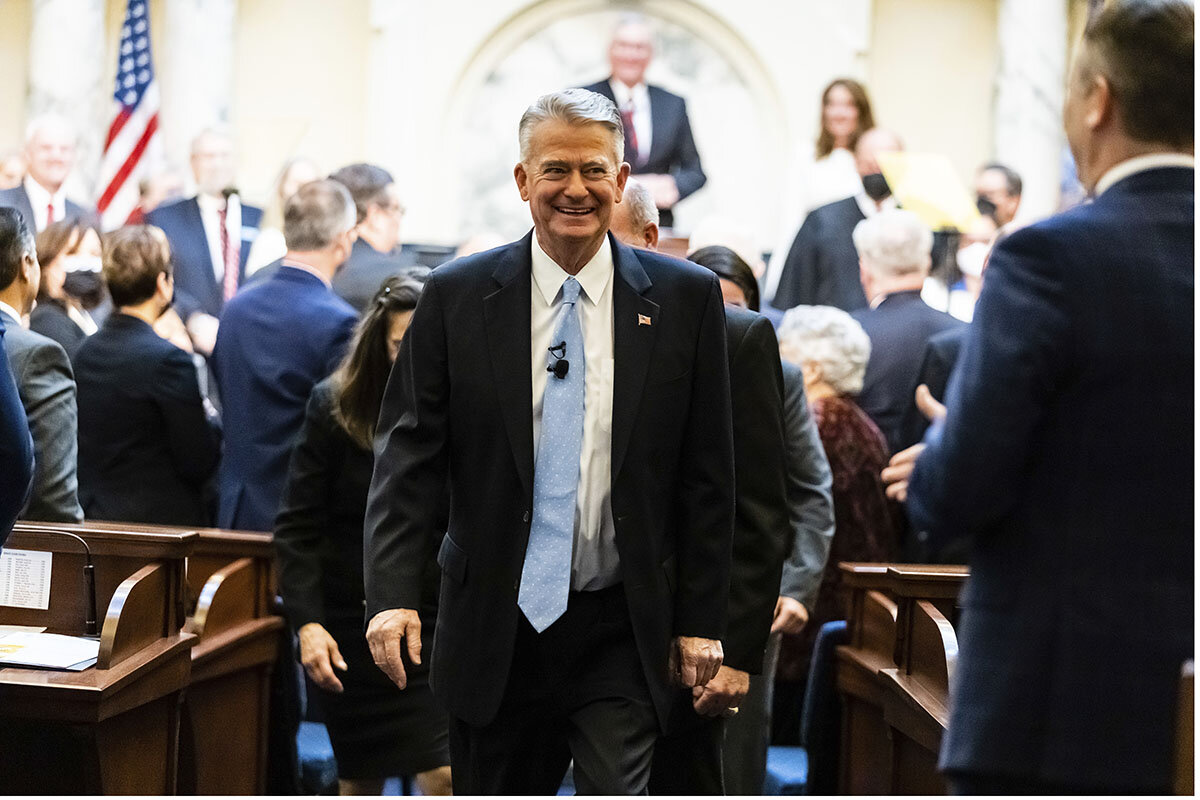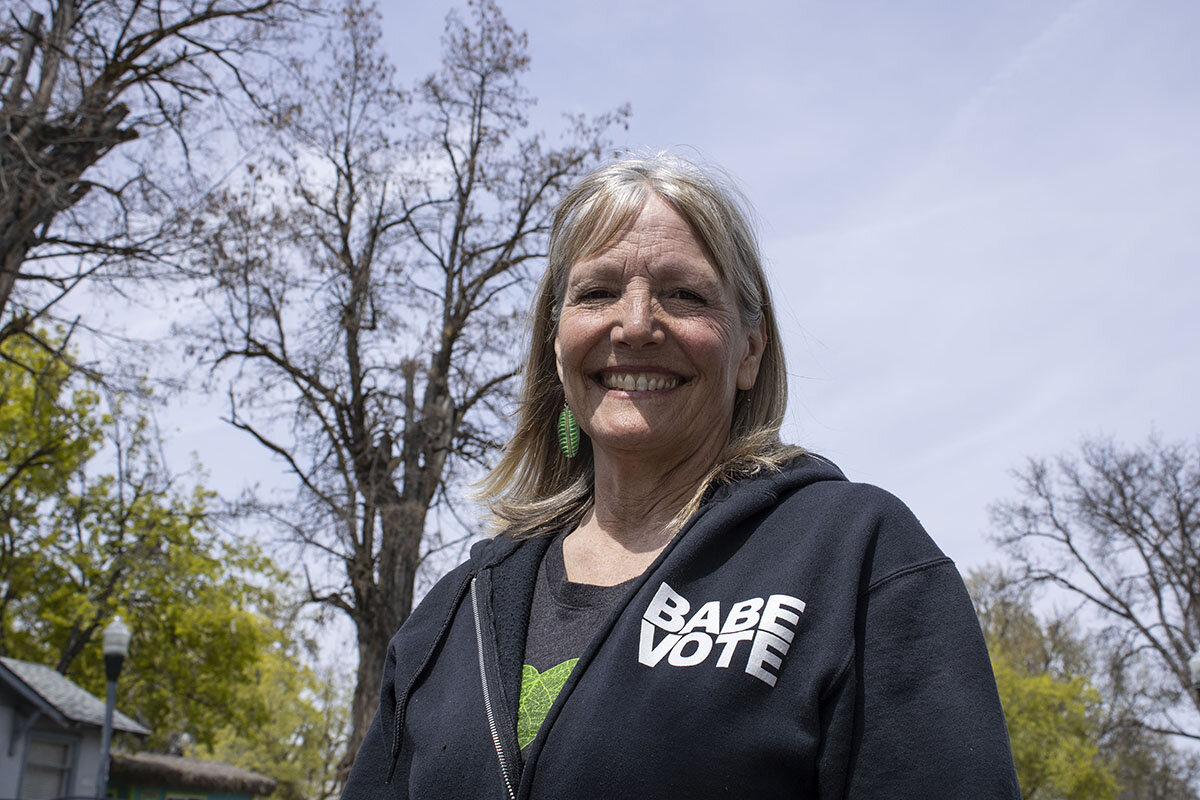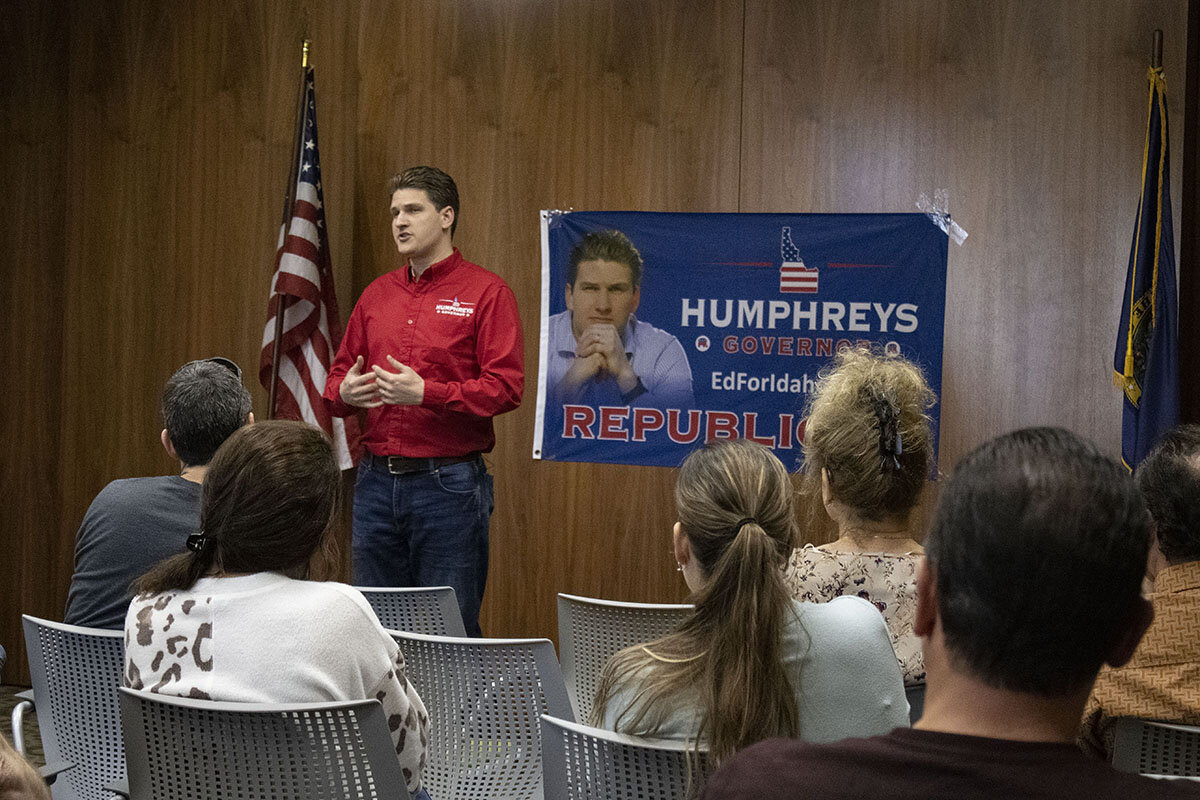In Idaho governor’s race, GOP factions battle over party’s future
Loading...
| Boise, Idaho
A chain saw revs as the governor slices through a log.
“Idaho’s economy is booming, because we cut government down to size,” Gov. Brad Little declares in a campaign ad, as sawdust spews.
Not to be outdone, his opponent, Lt. Gov. Janice McGeachin, fires a gun in a campaign ad of her own. “The Second Amendment wasn’t ratified into the Bill of Rights so that we could bird hunt,” she says.
Why We Wrote This
An unusual primary battle between the sitting governor and his lieutenant reflects national divisions within the Republican Party – over conservatism and extremism and, once again, Donald Trump.
Idaho’s top two officials – both Republicans, and both of whom come in for some chiding from online commentators for their lack of eye protection, not to mention form – are making their final appeals to voters in Tuesday’s gubernatorial primary as they square off in an unusual intraparty brawl.
As in many heavily Republican states, whoever secures the GOP nomination is expected to win easily in November. And as elsewhere, the race reflects deeper divisions within the national party – many of which still revolve around former President Donald Trump.
The governor and lieutenant governor (who run on separate tickets here) have been publicly feuding for more than two years. In the early weeks of the pandemic, Lieutenant Governor McGeachin drew national attention for her vocal opposition to Governor Little’s stay-at-home order. Twice, when Mr. Little was out of town, she issued her own executive orders banning mask and vaccine mandates. Twice, he rescinded them.
Ms. McGeachin has also pressed for a 50-state audit of the 2020 election. Last November, Mr. Trump, who lauded Mr. Little as a “terrific gentleman,” supercharged the race when he endorsed Ms. McGeachin the following week, calling her “a true supporter of MAGA since the very beginning.”
Many Republicans here say Idaho’s unique brand of Western conservatism has been undergoing something of an identity crisis, as it grapples with Trump-inspired populism and absorbs a steep influx of new residents, many of whom have relocated from blue states like California. If the first-term governor beats his Trump-endorsed lieutenant – as limited polling predicts he will – it could signal a growing resistance to a further-right pull in a deep-red state long known for an extremist streak.
“We’re seeing a little bit of fracturing of the Republican Party at the national level, particularly with respect to Trump. ... I would probably argue that we’re going through a political realignment,” says Markie McBrayer, assistant professor of political science at the University of Idaho. “It’s no real surprise that we’re seeing similar sort of factions occur at the state level.”
“We love Donald Trump”
Mr. Little is one of only two Republican governors nationwide who’s facing a Trump-endorsed challenger. The other, Georgia Gov. Brian Kemp, incited Mr. Trump’s ire over his refusal to overturn Georgia’s 2020 election results. In Idaho, however, the former president’s decision to weigh in seemed less a rejection of Governor Little than an embrace of Ms. McGeachin.
Other groups – including the Republican Governors Association and the National Rifle Association – are backing Mr. Little. Still, for many voters, Mr. Trump’s endorsement may count more.
“Part of the reason why we are leaning towards McGeachin is because Donald Trump endorsed her, and we love Donald Trump,” Lori Johnson says with a chuckle in the parking lot of a WinCo Foods supermarket in Twin Falls.
She and her mom, Peggy Mills, are conservative Christians and strongly opposed to abortion. Ms. Johnson says they moved to Idaho from Oregon in 2018 in part because they objected to public funding for abortion there. They also are concerned about inflation.
Mr. Little, on the other hand, has the vote of Sam Sandmire, a progressive activist and former gymnastics coach at Boise State University. Without contested races for Democrats on her ballot, she changed her registration from Democrat to Republican in order to vote for Mr. Little and others in the closed GOP primary. Although she considers him “very, very conservative,” she says she felt compelled to vote for the “less extreme” candidate in the race.
“I would say he is a more pragmatic voice,” she says outside a cafe in a tree-lined Boise neighborhood one blustery afternoon. “He’s more into governance than the other candidates on the ticket.”
A rancher and former state lawmaker as well as lieutenant governor, Mr. Little touts a pro-business record that includes tax relief, slashing regulations, and investment in education, with literacy as a top priority. Under his watch, Idaho has enjoyed low unemployment and a budget surplus that benefited from federal pandemic aid. The governor is the top fundraiser in the race with over $2 million raised – around triple that of Ms. McGeachin.
As in many places, divisions that sprang up in Idaho over COVID-19 still rankle. Governor Little’s stay-at-home order, announced on March 25, 2020, was criticized by some conservatives as anti-business, and Ms. McGeachin has continued to attack him as a tyrant who used the pandemic to flex his powers. The state began to reopen on May 1, 2020, and Mr. Little’s supporters say the uncertainty in the early days of the pandemic called for caution. Citing a limited-government approach, the governor has never issued a statewide mask mandate, instead deferring to local jurisdictions and school districts. He has also challenged the Biden administration’s vaccine mandates in court.
“There was no playbook,” says Idaho Republican Party Chair Tom Luna, who has stayed neutral in the primary.
That spring, Ms. McGeachin publicly protested the governor’s policies, aligning herself with small businesses that resisted shutting down. The business owner – her family runs an Irish pub and automotive enterprises – has also served in the state legislature and is the first female lieutenant governor of Idaho. Her campaign promises include lowering taxes, fighting public health mandates, and reducing dependence on Washington.
Critics have linked her to “extremists.” In 2019 it was discovered Ms. McGeachin posed for a photo with Three Percenters, part of a militia movement, at the statehouse; she said her presence was in support of Todd Engel, who was sentenced to prison for an anti-government standoff. (His conviction overturned, Mr. Engel is now running for state representative as a Republican.) This year, she drew criticism for addressing, via recording, a conference affiliated with a prominent white nationalist, in response to which she bemoaned the media’s tendency to assume “guilt by association.”
An “anti-extremism” push
This spring, a political action committee called Defend and Protect Idaho popped up with the stated mission of “combating political extremism.” Its website is almost entirely devoted to attacking Ms. McGeachin. The group’s focus is “civility, doing the right thing,” says Gary Raney, retired Ada County sheriff and chair of the PAC, who also praises Mr. Little as “not bowed down to the pressures of the right wing.” In an interview, Mr. Raney declined to name the group’s initial backers, noting some involved wish to “remain behind the scenes.”
Another PAC called Take Back Idaho is training its sights on the Idaho Freedom Foundation – an ultraconservative group that political observers say has had considerable influence in state politics and has been accused of stoking divisions within the GOP, for example by labeling fellow Republicans as “RINOs.”
“There’s more contention than there really needs to be,” says Ed Humphreys, a financial adviser and former Trump delegate who’s running a distant third in the GOP gubernatorial primary. He describes himself as “not with either faction of the party.”
Speaking to a small group at a library in Caldwell, Mr. Humphreys rails against critical race theory, vows to end state income tax, and pledges to curb the political influence of multinational corporations.
Roger, a retiree who moved to Idaho from California six years ago and calls himself a “political refugee,” says Mr. Humphreys has his vote.
From his job in court security in Northern California, he says he grew weary watching repeat offenders cycle through the justice system. He describes an improved quality of life here in Canyon County, including safer, cleaner parks for his visiting grandchildren.
People like Roger, who asked that his last name not be used, have helped make Idaho among the fastest growing states in the U.S. in recent years. For many, the reputation for conservative values is a significant draw, and some real estate firms cater explicitly to far-right buyers.
Of course, to those on the other side of the aisle, the Republican rift is more a matter of style than substance. “Janice McGeachin really personifies the far right, while Brad Little panders to it,” says state Rep. Lauren Necochea, chair of the Idaho Democratic Party.
She points to a bill Mr. Little signed that limits abortion after around six weeks and lets families sue abortion providers, though the governor expressed concern that allowing such civil enforcement could be “unconstitutional and unwise.” The Idaho Supreme Court has stayed the law’s rollout following a petition filed by a Planned Parenthood affiliate. An Idaho “trigger law” would criminalize abortion after the potential overturning of Roe v. Wade, with exceptions related to the life of the mother and cases of rape or incest. Ms. McGeachin has called for a “more comprehensive” ban on abortion.
Mr. Luna, the state GOP chair, agrees that there’s far more that unites the party than divides it. “As I travel across the state, it’s more obvious to me than ever that Republicans still agree on 80% of the issues.”
Still, he concedes wryly, “It is unusual to have a sitting lieutenant governor run against a sitting governor in the same party.” But once this primary’s finally behind them, Mr. Luna says, “we will begin the process of coming together.”









